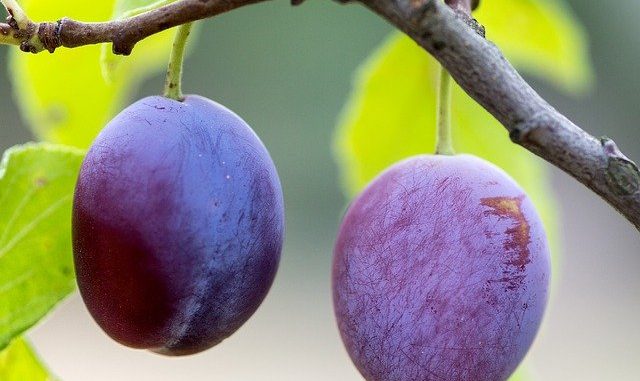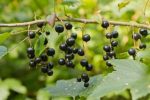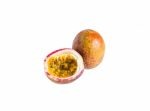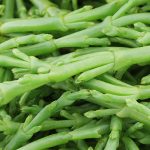
Plums! The taste of plums, a quintessential flavour of summer is second only to apples in our affections. They originally came down the Silk Road with Chinese traders who passed them on to the Romans. The Chinese were cultivating the fruit (Prunus domestica L.) in their temperate climates and the Romans found them ideally suited to the Northern European conditions they deserved. It is most likely they were greengage plums which are a set of slightly smaller varieties than the plums we see today.

We in Britain have about 300 cultivars. In China, they are treated by their chefs as a complement to savoury dishes but we find them excellent, baked in tarts, coated with honey and served with ice-cream. My grandmother simply stewed them which meant a few burnt mouths but a symbol of early autumn. They are also ideal for storage in Kilner jars but don’t keep for more than 6 months at a time. I think though that they are exceptional eaten fresh, having been plucked fresh from the tree. They also have a wonderful warm array of colour, from yellow to a deep purple/red colour. Most varieties ripen from mid-July through to early October. Unfortunately, most of the varieties never find their way to our shelves because plums are susceptible to damage and do not keep well.
Having recently been to our local nursery to pick up a ‘Victoria’ plum but we were careful to choose the right rootstock because normally the tree is exceptionally tall and shorter types are available. Most plum cultivars are self-fertile and so do not require other trees in the vicinity to produce their fruit but it would appear that the presence of other compatible plum trees helps with overall fruit production.
Cultivation
Plums can be trained into various styles and forms. The French were trying the idea of cordons in the late 1700s. We have tried cordons by fixing the fruit to a south, south-west wall which receives enough sun to keep the tree warm. A fence is an alternative decorative structure. Plum trees can also be free-standing, fan-trained or pyramid-trained against a wall to achieve about a 6m height and spread. These are made smaller than the standard orchard trees which can be up to 12m tall.
Originally, rootstocks did not exist that produced manageable tree heights for the smaller garden. The rootstock called ‘Pixy’, introduced in the mid-70’s helped restrict the extreme vigour of the plum tree. The scion, which is the fruiting cultivar grafted onto the rootstock is then restricted to about 2m which means it can be trained and managed more easily. There are other rootstocks available which allow for training including ‘St Julien A’ that restricts these to about 2.5m.
Plums are best grown as oblique cordons with the stems placed at an angle or as an upright. When planting a new tree or maiden as they are called, ensure the branches coming from the main stem (laterals) are kept to around 15cm and any shoots growing from these (known as sub-laterals) to 3cm.
Plum shoots are thin and whip-like, so pinching back regularly is essential and keeps the tree tidy and uniform. This is not the same as for the care of pears and apples. A main prune is conducted in July or early August, with pinching back occurring well into September.
With the newly planted tree established, pinch back all growth to one bud to restrict growth every three or four weeks.
Care For Plums
Grow plums in a sunny, sheltered spot on fertile, moisture-retentive soil. Prune when the sap is starting to flow which is between April and August and in dry weather. Seal any wounds to avoid the dreaded silverleaf disease.
Plum blossom is produced early in the fruit growing season, from early March to April and very prone to frost. Late flowering cultivars are ideal if frost is an issue or the fruit has to sit in a frost pocket. One good example is ‘Marjorie’s Seedling’. When a frost is likely to occur, cover smaller trees with old net curtains or horticultural fleece when the blossom is out. Greengages are more susceptible to frost and should thrive best against a sunny wall.
Thin the fruitlets in early summer to prevent trees from overcropping and producing lots of small fruit. The branches can snap as they do with apple trees and raise the potential for disease. The best situation is to leave one fruitlet every 5 to 8cm.
Cultivars
There is a large variety of fruit trees available for the gardener and they make very attractive plants for the garden especially in the early spring.
‘Victoria’ – the most famous and ubiquitous being introduced in 1840 to the UK. It is frost-resistant especially its flowers, self-fertile, an exceptional pollinator and generally a heavy cropper. Really ideal for northern Europe let alone most of the UK. The fruit can be eaten both fresh and cooked, usually being picked in late August. The fruits are a pale red/purple with heavy yellow. It achieved the Award for Garden Merit from the UK’s Royal Horticultural Society. Should be in everybody’s garden !
‘Marjorie’s Seedling’– a self-fertile, heavy cropping cooker type. Picked in September or leave the fruit on the tree until November for dessert quality fruit.



Leave a Reply